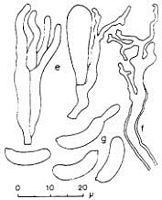|
 Eichleriella subleucophaea Eichleriella subleucophaea
BiostatusPresent in region - Indigenous. Endemic
Images (click to enlarge)
Caption: Eichleriella subleucophaea: e, basidia; f, branched dikaryophysis with basally thickened walls;
g, spores. |
Article: McNabb, R.F.R. (1969). New Zealand Tremellales - III. New Zealand Journal of Botany 7(3): 241-261 (http://www.rsnz.org/publish/abstracts.php).
Description: Fructifications firm-fleshy, resupinate,
thin, effused, indeterminate, originating as discrete circular or orbicular
patches, coalescing to form irregular, linear areas to 8 cm long, pruinose,
ochraceous brown to pallid brown when fresh, drying to a pallid tan crust, occasionally
with faint plum tints in older portions; margins concolorous or paler, arachnoid,
adnate. In section 150-300 µm thick, consisting of basal layer, intermediate
layer and hymenium. Basal layer well defined, composed of distinct, interwoven,
tinted, thick-walled hyphae 2.5-4.5 µm diam. with walls to l.5 µm thick, lying
parallel with substratum, clamp connections present. Intermediate layer composed
of thick-walled hyphae arranged parallel with substratum or obliquely ascending
from basal layer, clamp connections present. Hymenium composed of dikaryophyses
and basidia; dikaryophyses abundant, thick-walled basally, nodulose or finely
and irregularly branched apically, arising from thick-walled fertile hyphae;
probasidia crowded, narrowly obovate to clavate, proliferating through or near
basal clamp connections, 18.2-26 x 7.2-9.8 µm becoming longitudinally cruciate-septate;
sterigmata stout, cylindrical, to 28 x 3.5 µm. Basidiospores curved-cylindrical
to allantoid, hyaline, aguttulate, apiculate, 12.4-15.6-(16.9) x 3.9-4.9 µm.
Germination by repetition or by stout germ tubes.
Habitat: Dead angiosperm wood.
Notes: In microscopical characters, Eichleriella
subleucophaea closely resembles E. leucophaea Bres. but may be distinguished
by the firm-fleshy rather than coriaceous texture and adnate margins which do
not become reflexed on drying.
As currently accepted, the genus Eichleriella
is differentiated from Sebacina (sensu lato) by the tough coriaceous
texture, presence of a well developed basal layer composed of thick-walled hyphae,
and reflexed margins of dried fructifications. Many of the species included
in the genus appear to be quite unrelated. Wells (1961) regarded Eichleriella
incarnata Bres., the type species of the genus, as a synonym of E. alliciens
(Berk. & Cooke) Burt and transferred the latter to Exidiopsis. Eichleriella
was thus reduced to synonymy. The group of species related to E. alliciens,
including E. macrospora (Ell. & Everh.) Martin, E. leucophaea
and E. subleucophaea, form an essentially natural unit deserving generic
status, and the genus Eichleriella is accordingly retained.
|